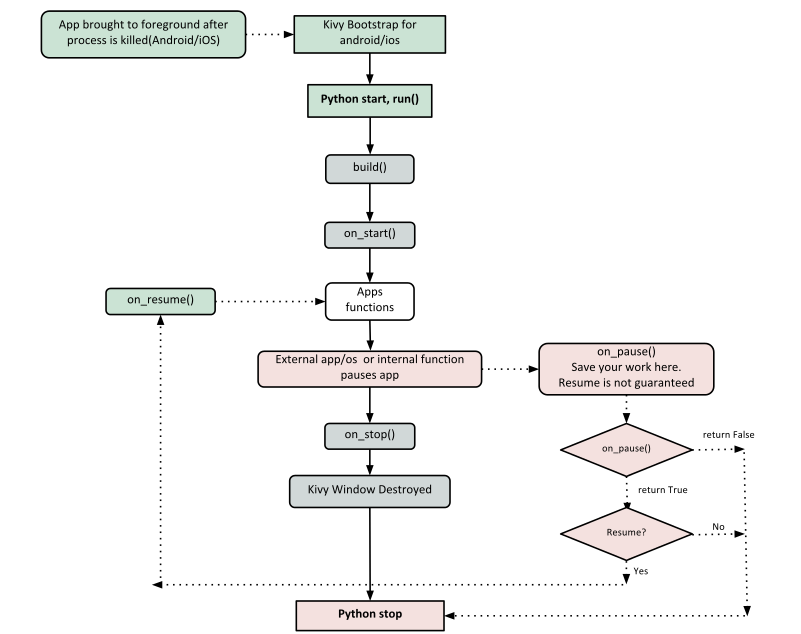kivy Create an application
http://kivy.org/docs/guide/basic.html#quickstart
I followed this tutorial about how to create basic kivy application
*********************
Creating a kivy application is as simple as:
- sub-classing the App class
- implementing its build() method so it returns a Widget instance (the root of your widget tree)
- instantiating this class, and calling its run() method.
Here is an example of a minimal application:
import kivy
kivy.require('1.0.6') # replace with your current kivy version ! from kivy.app import App
from kivy.uix.label import Label class MyApp(App): def build(self):
return Label(text='Hello world') if __name__ == '__main__':
MyApp().run()
You can save this to a text file, main.py for example, and run it.
*********************
LETS EXPLAIN IT!
##################
Kivy App Life Cycle
First off, let’s get familiar with the Kivy app life cycle.

As you can see above, for all intents and purposes, our entry point into our App is the run() method, and in our case that is “MyApp().run()”. We will get back to this, but let’s start from the third line:
from kivy.app import App
It’s required that the base Class of your App inherits from the App class. It’s present in the kivy_installation_dir/kivy/app.py.
Note
Go ahead and open up that file if you want to delve deeper into what the Kivy App class does. We encourage you to open the code and read through it. Kivy is based on Python and uses Sphinx for documentation, so the documentation for each class is in the actual file.
Similarly on line 2:
from kivy.uix.label import Label
One important thing to note here is the way packages/classes are laid out. The uix module is the section that holds the user interface elements like layouts and widgets.
Moving on to line 5:
class MyApp(App):
This is where we are defining the Base Class of our Kivy App. You should only ever need to change the name of your app MyApp in this line.
Further on to line 7:
def build(self):
As highlighted by the image above, show casing the Kivy App Life Cycle, this is the function where you should initialize and return your Root Widget. This is what we do on line 8:
return Label(text='Hello world')
Here we initialize a Label with text ‘Hello World’ and return it’s instance. This Label will be the Root Widget of this App.
Note
Python uses indentation to denote code blocks, therefore take note that in the code provided above, at line 9 the class and function definition ends.
Now on to the portion that will make our app run at line 11 and 12:
if __name__ == '__main__':
MyApp().run()
Here the class MyApp is initialized and it’s run() method called. This initializes and starts our Kivy application.
##################
kivy Create an application的更多相关文章
- kivy create a package for Android
Now that you've successfully coded an app. Now you want to deploy it to Android. So now we would nee ...
- maven command to create your application
How do I make my first Maven project? We are going to jump headlong into creating your first Maven p ...
- Java SE series:1. environment configure and Hello world! [We use compiler and packager to create an application!]
1. cli (command line interface) and gui (graphic user interface) use javahome path, search classpath ...
- [NativeScript] Create new application and run emulator
Install: npm i -g nativescript Create: tns create <app_name> --ng Run: tns emulate ios List al ...
- Create First Application
Node.js创建第一个应用 Node.js开发的目的就是为了用JavaScript编写Web服务器程序, 在使用Node.js时,不仅仅是在实现一个应用,同时还实现了整个HTTP服务器.在创建Nod ...
- How do I create an IIS application and application pool using InnoSetup script
Create an IIS application. Create a new IIS application pool and set it's .NET version to 4. Set the ...
- python3使用kivy生成安卓程序
技术背景 虽然现在苹果占据了很大一部分的市场,但是从销量数据来看,安卓还是占据了人口的高地.这里我们介绍一个用python的kivy+buildozer来进行安卓APP开发的简单教程,从整个过程中来看 ...
- cocos2d-x打飞机实例总结(一):程序入口分析和AppDelegate,Application,ApplicationProtocol三个类的分析
首先,是个敲代码的,基本上都知道程序的入口是main函数,显然,就算在cocos2d-x框架中也一样 我们看看main函数做了什么 #include "main.h" #inclu ...
- 应用程序域(Application Domain)
应用程序域为隔离正在运行的应用程序提供了一种灵活而安全的方法. 应用程序域通常由运行时宿主创建和操作. 有时,您可能希望应用程序以编程方式与应用程序域交互,例如想在不停止应用程序运行的情况下卸载某个组 ...
随机推荐
- 给Notepad++ 加右键菜单带图标
原文:给Notepad++ 加右键菜单带图标 从网上下载下来的Notepad++ http://download.tuxfamily.org/notepadplus/6.3.3/npp.6.3.3. ...
- 剖析Jetty实现原理
之前写一个简单易用Jetty文章.Jetty对于做JAVA Web发展的方面来说并不陌生,他是一个servlet集装箱,只有相对Tomcat这是比较简单的设计,并且也相对简单,使用灵活,我是学习和使用 ...
- Oracle OS认证和口令文件认证方法
OS认证 1.在SQLNET.ORA(位于$ORACLE_HOME/NETWORK/ADMIN文件夹中)文件里,使用vi编辑,凝视掉#SQLNET.AUTHENTICATION_SERVICES = ...
- ExtJs--15--Ext.is*各种类型推断的方法,简单看源代码就能够明确了
/** * Returns true if the passed value is empty, false otherwise. The value is deemed to be empty if ...
- dozer-初识
1.简介 dozer是一种JavaBean的映射工具,类似于apache的BeanUtils.但是dozer更强大,它可以灵活的处理复杂类型之间的映射.不 但可以进行简单的属性映射.复杂的类型 ...
- Asp.net vNext 2
Asp.net vNext 学习之路(二) View component(视图组件)应该是MVC6 新加的一个东西,类似于分部视图.本文将演示在mvc 6中 怎么添加视图组件以及怎么在视图中注入一个服 ...
- C#中使用REDIS
C#中使用REDIS 上一篇>> 摘要 上一篇讲述了安装redis客户端和服务器端,也大体地介绍了一下redis.本篇着重讲解.NET4.0 和 .NET4.5中如何使用redis和C# ...
- erlang mnesia数据库简单应用
mnesia是erlang自带的分布式数据库,基于ets和dets实现的.mnesia兼顾了dets的持久性和ets的高性能,可以自动在多个erlang节点间同步数据库.最关键的是,mnesia实现了 ...
- 四种方案:将OpenStack私有云部署到Hadoop MapReduce环境中
摘要:OpenStack与Hadoop被誉为继Linux之后最有可能获得巨大成功的开源项目.这二者如何结合成为更猛的新方案?业内给出两种答案:Hadoop跑在OpenStack上或OpenStack部 ...
- Mysql 使用CMD 登陆
1. 将mysql 的bin 目录加到 系统环境变量中: 这样的目的是为了可以直接在cmd中使用mysql命令,而不用先CD到mysql的bin目录中. 3. 连接目标数据库 . Syntax: ...
